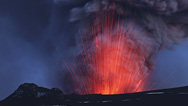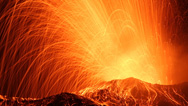Meet the Volcanoes
- Posted 01.03.13
- NOVA
In big blockbuster films, all volcanoes look the same: they are huge pointed peaks that violently erupt, destroying everything in their path. While some volcanoes do look like their Hollywood stand-ins, many others do not. In fact, they vary in size, lifespan, and even in the way they erupt.
Transcript
Meet the Volcanoes
Posted: January 3, 2013
Narrator:You probably have a pretty good idea what this is. It’s a volcano—a place where molten rock, called magma, from deep within the Earth, makes its way up and erupts at the surface. But what you may not know is that not all volcanoes are made in exactly the same way. In fact, they come in a variety of different shapes and sizes. Here are the three main types of volcanoes.
The smallest type of volcano is the cinder cone. Cinder cones form when thin or runny magma is flung in the air during an eruption, and then hardens and falls back to earth in fragments called “cinders.” Over time, these cinders build up, creating a cone shaped mound. Cinder cones can form rapidly, and are the shortest-lived volcanoes. A famous one is the Parícutin volcano, which formed in a Mexican cornfield in 1943. It was active for only nine years, but in that time it transformed what was once farmland into a 1,200-foot high peak, destroying two villages in the process.
The largest type of volcano is the shield volcano. These volcanoes pour out very runny lava flows, which can travel many miles. When the flows cool, they form thin sheets. These sheets build up to form a wide dome that resembles a warrior’s shield. Despite their size, they’re actually the gentlest volcanoes. In fact, tourists can actually watch the slow flow of lava from the shield volcanoes that form the Hawaiian Islands.
The most common type of volcano is the composite, or stratovolcano. These are what most people think of when they imagine volcanoes. They usually come in groups of volcanoes all aligned in a chain. They’re formed from alternating lava flows, and layers of hardened particles called tephra that are flung out of the volcano during an eruption. Composite volcanoes have the most violent eruptions, because the lava they eject is stickier, or more viscous, than the lava from cinder cones or shield volcanoes. As a result, more pressure builds up in the volcano before an eruption.
Some composite volcanoes have what is known as a “lava dome” grown on the top, often within the volcanic crater. These form when thick, very viscous lava gets pushed up over the vent like toothpaste and hardens, creating a sort of lid on the volcano. Volcanoes with lava domes have very forceful eruptions, because the magma has to push its way through the lid. Mt. St. Helens famously grew a lava dome in the crater that formed during the 1980 eruption.
These are the three main types of volcanoes, but there’s plenty more explosive science to discover.
Credits
PRODUCTION CREDITS
- Produced, animated, and edited by
- Anna Rothschild
- Original Footage
- ©WGBH Educational Foundation 2013
- Special thanks to
- Valbone Memeti
ADDITIONAL IMAGE AND VIDEO
- (Fujisan from Yamanakako 2004-2-7)
- Public Domain/Wikimedia Commons
- (Lava Flows on Mauna Loa)
- Courtesy of the U.S. Geological Survey
- (Aguitaenlamananita 2008)
- Public Domain/Wikimedia Commons
- (MountVsevidof)
- Courtesy of the U.S. Geological Survey/Wikimedia Commons
- (Capulin 1980 tde00005)
- Courtesy of the U.S. Geological Survey/Wikimedia Commons
- (Capulin Volcanon in New Mexico)
- FlickrLickr/Wikimedia Commons
- (Paricutin)
- Karla Yannín Alcázar Quintero/Wikimedia Commons
- (Parícutin Volcano)
- Public Domain/Wikimedia Commons
- (Paricutin 30 613)
- Courtesy of the U.S. Geological Survey/Wikimedia Commons
- (Paricutin 30 612)
- Courtesy of the U.S. Geological Survey/Wikimedia Commons
- (Lava Flowing Into a Seemlingly Bottomless Crack)
- Courtesy of the U.S. Geological Survey
- (Mount St. Helens: May 18, 1980)
- Courtesy of the U.S. Geological Survey
- (MSH82 st helens spirit lake reflection 05-19-82)
- Courtesy of the U.S. Geological Survey/Wikimedia Commons
- (Novarupta)
- National Park Service/Wikimedia
- (Mount St Helens lava dome Spirit Lake)
- TJK/Flickr
- (Lava Dome, Mt Saint Helens 3 Years After May 18, 1980 Eruption)
- NOAA/NGDC, University of Colorado at Boulder
- (Lava Fountaining from a Dominant Vent)
- Courtesy of the U.S. Geological Survey
- (main image: volcano cartoon)
- ©WGBH Educational Foundation 2013
Related Links
-

Doomsday Volcanoes
Could the explosion of Iceland's ticking time bombs cause cold and famine worldwide?
-

Deadliest Volcanoes
From Japan's Mt. Fuji to Yellowstone's buried supervolcano, how can we best prepare for the most lethal eruptions?
-

Anatomy of a Volcano
Explore the parts of a volcano such as Mt. St. Helens and see what causes destruction during a volcanic eruption.
-

A Volcanic Labyrinth
See the only place on the Earth where scientists can study a volcano from the inside.

